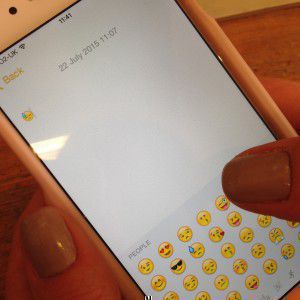Emoji: The New Universal Language?
👋👇👌 – Hi, are you okay?
👍☺️ – I’m good thanks!
👏 – yay!
Or something like that.
Welcome to the wonderful language that is emojis 😁
And before you express concern that we are confused about what is a language and what is not, hey. Your entire screen staring back up at you currently is composed of a series of ones and zeros, manipulated into the glorious thing you see before you and that, the ones and zeros, is a language all in itself. Binary code. If you’re interested.
Emojis are much, much prettier to look at than a bunch of ones and zeros though, aren’t they?
😖?
Yes, we know. Emojis can be confounding to us too. But a language is a language, and language learning is good for our cognitive reasoning 😇
So let us give you a little introduction into the wonderful world of emojis, see if we can entice you in or relieve you of your confusion. Here are some reasons why we vote emojis as our new favourite international language.
✒️📚🕐 study time!
- So firstly, you may have heard of emoticons. Emoticons are not emojis, repeat, they are not emojis ‼️ Emoticons are ‘pictures’ composed of the keyboard symbols we already have, such as :), :(, and :D. Even our mothers know how to use them.
- Emojis originate from Japan and are, like Japanese characters themselves, pictographs. The word itself means ‘picture’ – e and ‘character’ – moji. Another argument in favour of emojis being a language, don’t you think?
- Emojis actually have specific, individual meanings but in the way that colloquial language changes and adapts, they can mean different things to different people. For example, 😋 ’officially’ means face savouring delicious food, but whenever we use this in our Whatsapp messages, it generally means we are being exceptionally cheeky. Tongue sort-of in cheek, see?
- Emojis are a beautiful, universal thing, allowing people to communicate when normal language barriers would apply. And there’s no grammar! Truly, this is a joyous thing.
- Emojis are also doing their bit for diversity. The latest versions of iOS offer emoji with different skin tones:
- and the generic ‘one size fits all’ ones…
- …and those for people of the LBGT community, 👭👬🌈❤️. But none for redheads apparently. There’s a campaign on Change for that at the moment.
- Emojis are multi-platform. You can use them, in various versions on all devices, and everyone is in on the act. Even National Rail Enquiries, who, on World Emoji Day last Friday, invited Twitter followers to guess station names using a series of emojis.
It’s #WorldEmojiDay ! (Yes, it exists…) See if you can solve our quiz For help: http://t.co/wkstHtiOKE pic.twitter.com/gQGnKy4X5C
— National Rail (@nationalrailenq) July 17, 2015
- Emojis can shorten your messages and bring a smile to a recipient’s face: even if it’s just because they’re trying to understand what you mean:
🎄👜🙏?
Please come Christmas shopping with me?
✈️🎫😘
Enjoy your holiday in Cyprus!
😈🍹💻🕔?
Join me for a cheeky drink after work?
- Some businesses will even let you order dinner via Twitter: 🍕
We could go on. But we’d probably get silly.
So the next time someone shows disdain for your messages full of emojis, you are well within your rights to reply with a 😝 that says hey, I’m learning a new language here!
Are you for or against emoji? Tell us what you think!
Kelly
Language of the Week: Esperanto
Here at EuroTalk, we love languages (obviously). And we particularly enjoy discovering fun facts about languages; they’re all so different and each has its own unique character. So we’ve decided to bring back the Language of the Week series. Each week, we’ll choose a new language, and we’re always open to suggestions!
Please do get involved – we love to hear from you, so join in the conversation here on the blog, or on Facebook or Twitter.
This week’s Language of the Week is Esperanto, to celebrate its release as the 128th language in our uTalk app, which we’re very excited about…
Some of you may not have heard of Esperanto, or you may want to learn some more about it; so here are some interesting facts about the world’s most widely spoken constructed language:
 Dr Zamenhof introduced Esperanto in 1887; his aim was to allow people from many different native languages to communicate with each other through a second shared language, whilst retaining their individual cultural identities.
Dr Zamenhof introduced Esperanto in 1887; his aim was to allow people from many different native languages to communicate with each other through a second shared language, whilst retaining their individual cultural identities.
- Esperanto’s full name is ‘Doktoro Esperanto’, which translates into ‘one who hopes’ – this reflects the aim of Dr Zamenhof, who wanted this language to create peace and diplomacy across the world.
- Although the language did not become as popular as Dr Zamenhof predicted, today there are still a large number of people who speak the language. Estimates range from 10,000 fluent speakers to 2 million people who understand quite a lot, and it is spoken all over the world. There are also over 1,000 native speakers of the language:
- The four main languages that Esperanto’s roots are taken from are Italian, French, German and English. However, Esperanto has no irregular verbs – unlike French, which has over 2,000!
- J.R.R. Tolkien had a huge interest in Esperanto, stating that people should ‘back Esperanto loyally’. He even had his book The Hobbit translated into Esperanto.
- Esperanto is believed to be easier to learn than any other language. Here are some simple phrases:
Smile! – Ridetu!
Have a good day – Bonan tagon
Have a cup of tea – Havu tason da teo
Do you know any Esperanto? We’d love to hear from you! Feel free to say hello in the comments below, join us on Facebook or tweet us @EuroTalk 🙂
Alex
The importance of Body Language when learning a new language
Today we’re happy to welcome back Izabella Klein, who spent some time with us last year while she was translating the onebillion maths apps into Brazilian Portuguese. Izabella’s new post focuses on a language we all speak, even if we don’t realise it…
Starting next year I will go back to teaching English as a second language. In the meantime I am recalling all the grammar points, reminding myself what to do in a classroom, as well as emphasising the key points when learning a new language. During this process, I thought of myself as a linguist constantly studying new languages: either technical languages or a new language spoken elsewhere in the world.
This moment of reflection and remembrance made me realise in a more mature way how body language is not only important in daily conversation, but it is the ‘real universal language’, since it is the only language that in fact everyone in the world can use. So, it becomes really important when learning/teaching a new language. I would say it is the first key to follow into teaching any new language.
 For instance, how do we recognise body language? Probably when we realise when someone is sad or happy, thrilled or devastated just by their faces and body movements. So body language is when we can interpret without a word being said – only by our eyes observing someone using body language. Old black and white movies are great examples when we notice how they used much more body language than movies nowadays. No sound, no words, all they had were scenarios, costumes and body language to make people laugh or cry.
For instance, how do we recognise body language? Probably when we realise when someone is sad or happy, thrilled or devastated just by their faces and body movements. So body language is when we can interpret without a word being said – only by our eyes observing someone using body language. Old black and white movies are great examples when we notice how they used much more body language than movies nowadays. No sound, no words, all they had were scenarios, costumes and body language to make people laugh or cry.
Now think of an international film festival you’ve been to, or just any foreign movie you’ve watched one day, in a language you either don’t speak at all or at which you are still basic or intermediate level. If you got tired of reading the subtitles, or you’re a language geek like me, always trying to understand what people say even if it’s an unknown language, you had to go with ‘trying to figure it out’ by listening to the sound of the words said by the characters and observing the body language they were using while saying it.
So don’t go taking any conclusion in advance, thinking you will not be able to understand anything at all, just because you don’t speak the language. Relax and watch the movie, observe what the characters do. I bet you will understand more than you imagine and you will learn even if only a little bit of that language.
Meeting foreign people in person and socialising with them is also a great opportunity of observing and learning a new language and culture. We have such opportunities when we travel abroad, have a foreign friend coming over, when we chat with a friend via Skype or similar, or when we have a language teacher.
But if you don’t have those at the moment but you still want to learn, multimedias are really efficient not only for entertainment, but for education purposes as well. We are able to observe images, while we listen and even read. We use both our eyes and our ears; these senses, at the same time connected and alert, increase learning possibilities. And we see not only scenarios and costumes that help identify cultural aspects. We also see body language as a key to trying to figure out what is being said or even really understand what is being said, together with words that might sound familiar due to having the same linguistic routes as another language you already learnt.
Did you ever have a language teacher trying to introduce some new vocabulary in class, acting like a drama teacher, using a lot of mimes and weird sounds trying to make you understand the meaning of the new words? She was not just acting CRAZY, she was trying to make you learn like babies do, by observing. So, pay attention to body language, it will definitely help you learn other languages. As for me, I will probably take drama classes to help me improve my body language skills in class…
Izabella Klein


